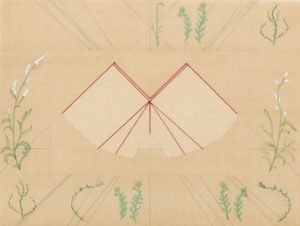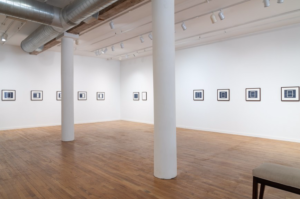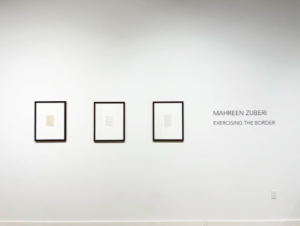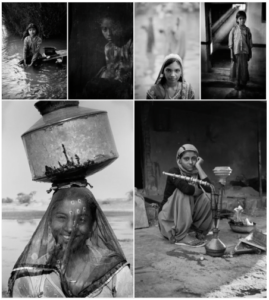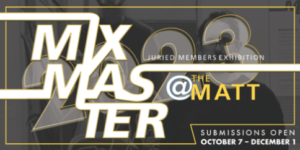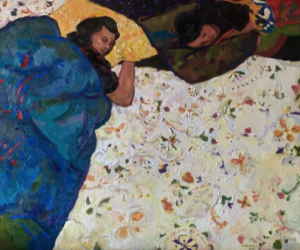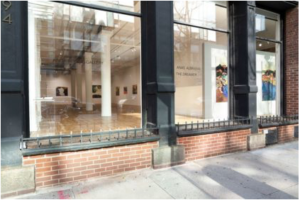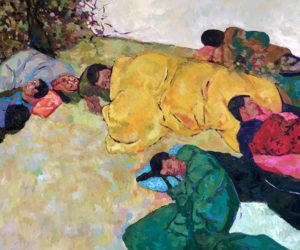Mahreen Zuberi, Mapping (2), 2023, Gouache and pencil drawing on wasli, 10″ x 12″
Beyond the Surface
On Mahreen Zuberi’s Exercising the Border
At Anita Roger’s Gallery, NY
By Joanna Seifter
Meaning, an immaterial concept, is only made perceptible when merged with form, a material object–meaning’s diametric opposite. When an idea marries a surface, it creates a painting, a physical manifestation of the artist’s vision and insight. In turn, it can inspire countless meanings with audiences now and forever, inhibited to the surface’s length and width. But what if these restrictions are mitigated, even obliterated, unleashing meaning into the corporeal world in infinite directions?
These are the impenetrable concepts made accessible by “is/is not” and “in between 1/8”, the first two works featured in contemporary painter Mahreen Zuberi’s latest entry at Anita Rogers Gallery, “Exercising the Border”. Zuberi’s manifesto, deftly synthesizing metaphysical theory and poetry with fine art, is a fitting introduction to her solo show, a quietly momentous rumination on the relationship between artist and environment and the limitless potential of creativity when unfettered from imposed constraints.
The exhibition’s first illustrative painting, “is/is not (i)”, succinctly and brilliantly establishes a visual foundation that Zuberi and her audience can apply to her other works. “is/is not (i)” presents an austere, off-white rectangle on a sheet of A4 paper. “A piece of paper has 4 vertices joined by 4 lines that define its space,” proclaims text adjacent to the rectangle. Inside the rectangle reads, “Anything within the lines is paper,” establishing the shape as the surface’s focal point, a biosphere confined between the 4 vertices and 4 lines. Immediately underneath the preceding sentence and on the perimeter of the rectangle states, “Anything outside the lines is not paper,” eliminating the negative space entirely.
Each painting in Zuberi’s haunting “Crossing Over” series features geometric clusters of stars in an inky sky accented by a thick, blindingly white border, a simple yet strikingly stunning image. The borders do not outline the stars’ contours, nor do they contain them the way picture frames protect photographs. Rather, they overlap the star clusters as the forms trickle past them. When implementing Zuberi’s guidelines from “is/is not (i)”, the space surrounding the overlapping shapes and the frame is the physical world beyond the artist’s eye, the “not paper.”
The shapes’ continuance outside their white borders expands the seemingly self-contained frame, the immaterial “paper,” into the worldly realm. “Crossing Over (5)” ia a membranous structure made of stars underscores this point, suggesting its permeability. Zuberi also explores this thematic thread in her “Mapping” series. Each painting invokes colonial cartography (including aged paper and detailed studies of local fauna) while cleverly subverting its purpose (the series of lines that would ordinarily distinguish regions are fragmented, replacing divided territories with unified land), calling the arbitrarily restrictive nature of borders into question.
Like the lines in “Mapping”, “Crossing Over’s” frames also presents a series of directional lines invoking architectural drawings of three-point perspective, each of which begins outside the white border and elongates past the works’ perimeter. Zuberi also includes these lines in her “Limits” series, geometric forms atop multi-axis graphs. “The lines that stop at the edge of the paper extend beyond infinitely when extended into the imagination,” she explains in “Limit 1/8”. These directional lines are also present in Zuberi’s “Borders” series, which, like “Crossing Over”, also features starry skies. Unlike Crossing Over, Borders’ white structures vary in width, stretching from painting to painting. The frames in “Borders” resemble the negative space in film strips–ostensibly a sequence of vignettes–capturing a specific duration, implying that “Borders” is a continuous narrative as opposed to isolated images.
Series like “Borders” are a conduit to employ Zuberi’s artistic and philosophical framework to our conceptualization of time itself. “The night sky allows us to see the many pasts in cohesion,” writes Zuberi in “Possibilities 1/8”. “By developing the capacity to practice pushing borders we may find that within the limit is that which is unlimited.” “Exercising the Border” reflects Mahreen Zuberi’s keen ability to represent time surpasses intervals or even life cycles–her artworks, small in scale yet immensely powerful in scope, encompass billions of years, traversing the past, present and whatever the future may.
